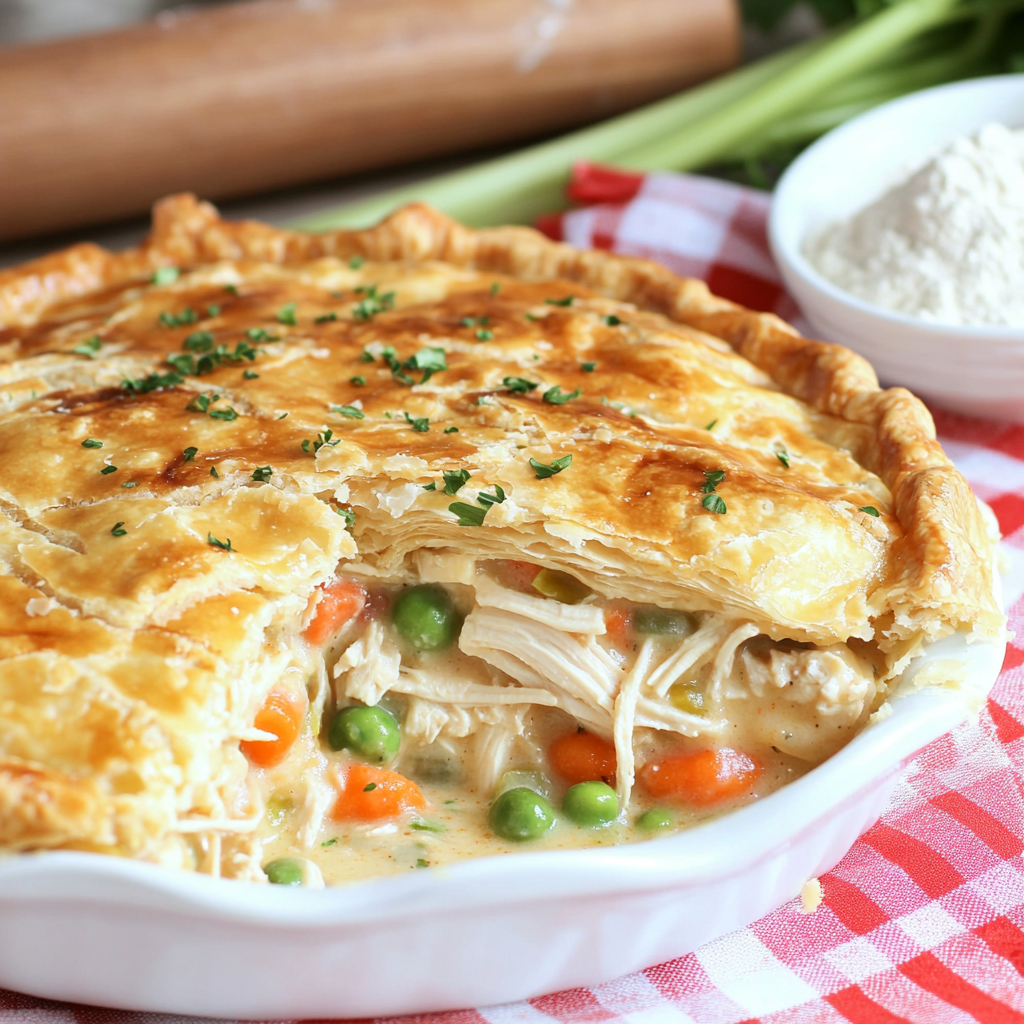Chicken Pot Pie: A Comforting Classic with Homemade Crust

Share
Making Crust Isn’t Really Too Hard to Do
Coming from a Ukrainian background, I was no stranger to 'helping' in the kitchen when I was little. My mother was always busy preparing something delicious, and whenever she made piecrust dough, a little stool would be pulled up near the counter just for me. I remember the excitement of getting my own little piece of dough to knead and roll. I’d work at it until it was hard and crumbly, but to me, it was a masterpiece. Those moments in the kitchen were more than just learning how to cook—they were about creating memories, feeling included, and building a love for food that has stayed with me throughout my life. Now, when I make my own pie crusts, I often think back to those times with a smile, grateful for the skills and the love that were passed down to me.
Did You Know?
Chicken pot pie dates back to medieval times and was a way to use leftover meat and vegetables. The pot pie has evolved over the centuries and remains a beloved comfort food. Fun fact: In ancient Rome, pot pies were sometimes topped with live birds that flew out when the pie was cut open!
Recipe:
Yield: 4 servings
Ingredients:
Filling:
- 2 tablespoons butter
- 1 large onion, chopped
- 2 carrots, diced
- 2 celery stalks, diced
- 2 cups cooked chicken, shredded
- 1/4 cup all-purpose flour
- 2 cups chicken broth
- 1/2 cup milk
- 1 cup frozen peas
- 1 teaspoon dried thyme
- Salt and pepper to taste
Pie Crust:
- 1 1/4 cups all-purpose flour
- 1/2 teaspoon salt
- 1/2 cup cold unsalted butter, cubed
- 1/4 cup ice water
Instructions:
Make the Pie Crust:
In a large bowl, combine the flour and salt. Cut in the cold butter until the mixture resembles coarse crumbs. Gradually add ice water, mixing until dough forms. Wrap in plastic wrap and refrigerate for at least 30 minutes.
Personal Tip: Don’t worry if the dough isn’t perfect—patching up small tears is part of the process!
Preheat the Oven:
Preheat your oven to 375°F (190°C).
Sauté the Vegetables:
In a large skillet, melt the butter over medium heat. Add the onion, carrots, and celery, and cook until softened, about 5 minutes.
Personal Tip: Cooking the vegetables just right adds a nice texture to the filling.
Add Chicken and Flour:
Stir in the shredded chicken and flour, cooking for 2 minutes until the flour is absorbed.
Personal Tip: Make sure the flour is well-incorporated to avoid lumps in the sauce.
Add Broth and Milk:
Gradually add the chicken broth and milk, stirring continuously until the mixture thickens. Stir in the frozen peas, thyme, salt, and pepper.
Personal Tip: Keep stirring to ensure a smooth and creamy filling.
Assemble and Bake:
Transfer the mixture to a pie dish. Roll out the pie crust on a floured surface and place it over the filling. Crimp the edges to seal and cut slits in the crust for steam to escape. Bake in the preheated oven for 25-30 minutes, or until the crust is golden brown.
Personal Tip: If the edges start to brown too quickly, cover them with foil.
Serve:
Allow the pot pie to cool slightly before serving.
Personal Tip: Letting it rest helps the filling set, making it easier to serve.
Nutritional Information (Per Serving):
Calories: 450, Protein: 25g, Carbohydrates: 35g, Fiber: 4g, Net Carbohydrates: 31g, Fat: 22g, Saturated Fat: 10g, Cholesterol: 85mg, Sodium: 700mg, Sugars: 6g, Glycemic Index: Medium
Kitchen Tips, Great Ideas, How to Save Money
- Using Leftover Chicken: This recipe is perfect for using leftover roast chicken or rotisserie chicken, saving time and reducing waste.
- Vegetable Variations: Feel free to add other vegetables like corn, green beans, or mushrooms for added flavor and nutrition.
- Store-Bought Crust: If you're short on time, you can use a store-bought pie crust. It won't be as buttery and flaky as homemade, but it will still be delicious.
- Thickening the Filling: Ensure the filling is thick enough by letting it simmer until it reaches the desired consistency before transferring it to the pie dish.
- Herb Substitutes: Fresh thyme can be substituted with dried thyme or other herbs like rosemary or sage for different flavor profiles.
- Freezing Tips: Prepare the filling in advance and freeze it in an airtight container. When ready to use, thaw, add to a pie dish, top with crust, and bake.
- Cheese Addition: For a twist, stir in a handful of shredded cheese into the filling before adding the crust. Cheddar or Gruyère work well.
- Making Mini Pies: Use muffin tins to make individual mini pot pies, perfect for portion control and serving at parties.
- Crust Alternatives: For a lighter version, use phyllo dough or puff pastry as the topping.
- Cost-Saving Tips: Buy chicken and vegetables in bulk when on sale. Using store-brand ingredients can also help reduce costs without compromising quality.
It’s Okay If It’s Not Perfect
When we’re learning something new, things don’t always turn out exactly as we hoped—and that’s perfectly okay. Whether you’re making a pie crust for the first time or tackling a challenging recipe, there will be bumps along the way. The key is to keep trying, learn from each experience, and enjoy the process. This idea applies to more than just cooking—it’s a valuable life lesson as well. So the next time your pie crust isn’t picture-perfect, remember that it’s the love and effort that counts, and each attempt brings you closer to mastering the skill. Plus, even a less-than-perfect pie is still delicious!


